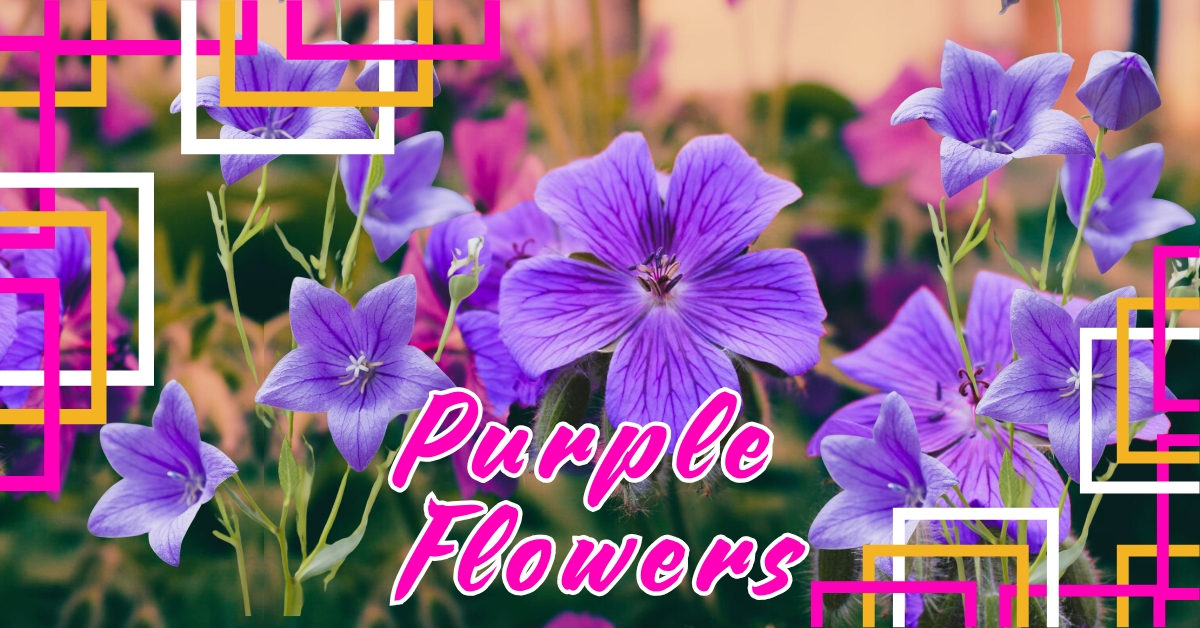Purple flowers are known for their vibrant beauty and calming presence. Whether you’re looking to add a pop of color to your garden or create a soothing outdoor sanctuary, purple flowers are an excellent choice. In this guide, we’ll explore the best purple flowers for your garden, how to care for them, and their deeper symbolism. Let’s dive in and discover how these stunning blooms can elevate your outdoor space!
Why Purple Flowers Are Popular in Landscaping
Purple flowers are a favorite among gardeners and landscapers alike. Their rich, royal hues evoke a sense of luxury and peace, making them a go-to choice for creating elegant garden designs. Additionally, purple flowers contrast beautifully with green foliage and other brightly colored flowers like yellow, orange, or white. Whether you’re looking to fill borders, planters, or create a focal point, purple flowers can instantly upgrade your landscape with minimal effort.
Beyond their aesthetic appeal, many purple flowers are also known for attracting beneficial pollinators such as butterflies and bees. Their bold colors and sweet nectar draw these creatures, promoting a healthy ecosystem in your garden.
How to Grow and Care for Purple Flowers
Caring for purple flowers is relatively easy, but each variety may have specific needs regarding sunlight, water, and soil conditions. Let’s take a look at some general care tips for maintaining healthy and vibrant purple blooms in your garden.
- Sunlight: Most purple flowers thrive in full sun, though some varieties prefer partial shade. Be sure to check the requirements of each plant species to give them the right amount of sunlight.
- Watering: Water deeply, but avoid over-watering as this can cause root rot. Many purple flowers are drought-tolerant once established.
- Soil: Purple flowers typically prefer well-drained soil rich in organic matter. Adding compost to your soil can help improve its fertility and drainage.
By following these simple steps, you can ensure that your purple flowers stay vibrant and healthy throughout the growing season.
Types of Purple Flowers for Every Garden
There’s a wide variety of purple flowers to choose from, each with its own unique beauty. Here are some of the best types of purple flowers that you can plant in your garden:
1. Lavender (Lavandula)
Lavender is one of the most popular purple flowers, loved for its aromatic scent and ability to thrive in hot, dry conditions. These purple flowering plants are ideal for borders, containers, or even as a fragrant addition to your herb garden.
2. Purple Coneflower (Echinacea purpurea)
Purple coneflowers are hardy perennials that attract butterflies and pollinators. Their large, daisy-like flowers can add height and drama to any garden.
3. Wisteria
Wisteria produces cascading clusters of purple flowers, perfect for climbing over trellises or pergolas. These fast-growing vines are excellent for creating shade and a beautiful focal point in any outdoor space.
4. Salvia (Salvia nemorosa)
Salvia is a versatile, low-maintenance plant known for its spiky purple blooms. It’s an excellent choice for borders and attracts bees and butterflies to the garden.
5. Allium
Alliums are unique, globe-shaped flowers that can add a modern touch to your garden. Their tall stems and spherical clusters make them ideal for adding height to flower beds.
6. Iris (Iris germanica)
With their delicate, ruffled petals, irises are a classic addition to any garden. These perennials bloom in spring and come in various shades of purple.
7. Clematis
Clematis is a climbing plant that produces large, showy purple flowers. It’s perfect for covering fences or walls and adds a romantic touch to any garden.
8. Petunias
If you’re looking for an easy-to-grow annual, petunias are a great option. Their vibrant purple flowers are perfect for hanging baskets or window boxes.
9. Hydrangea
Hydrangeas can bloom in stunning shades of purple, depending on the pH of your soil. These large flowering shrubs are perfect for creating lush, colorful garden displays.
10. Verbena
Verbena is a trailing plant with clusters of small purple flowers, making it ideal for hanging baskets or ground cover. It thrives in full sun and is a favorite among pollinators.
Symbolism of Purple Flowers: What They Mean in Different Cultures
Purple flowers have a rich history of symbolism and are often associated with royalty, luxury, and wisdom. In various cultures, purple flowers can convey different meanings, such as:
- Royalty and Nobility: Throughout history, purple has been considered the color of royalty. In ancient times, purple dye was rare and expensive, making it a symbol of wealth and power. Purple flowers are often used in arrangements to symbolize dignity and grandeur.
- Spirituality: Purple is also associated with spiritual awareness and enlightenment. Flowers like lavender and iris are often used in religious ceremonies and meditative practices.
- Creativity and Mystery: Purple is a color that inspires creativity and imagination. Many people choose purple flowers to express their artistic side or to create an air of mystery in their garden.
Best Purple Perennial Flowers for Low-Maintenance Gardens
For gardeners looking to add long-lasting beauty to their outdoor space, purple perennial flowers are an excellent choice. Perennials return year after year, offering a low-maintenance solution for vibrant gardens. Here are some of the best purple perennials to consider:
- Catmint (Nepeta): This hardy perennial produces lavender-purple flowers and is incredibly drought-tolerant. It’s perfect for dry climates and can add color to rock gardens or borders.
- Russian Sage (Perovskia atriplicifolia): Russian sage features tall spikes of silvery-purple flowers that bloom from summer to fall. It’s a low-maintenance plant that thrives in full sun.
- Lupine (Lupinus): Lupine produces tall spires of purple flowers and is perfect for cottage gardens or naturalized areas. These hardy perennials attract butterflies and hummingbirds.
How to Use Purple Flowers to Attract Butterflies and Pollinators
If you want to attract more butterflies and pollinators to your garden, purple flowers are an excellent choice. Here’s how you can use them to create a pollinator-friendly space:
- Plant in Groups: Butterflies and bees are more likely to visit gardens where flowers are planted in large groups. Consider planting several purple flowering plants together to create a dense, colorful display.
- Choose Nectar-Rich Varieties: Flowers like lavender, salvia, and purple coneflower are nectar-rich, making them ideal for attracting pollinators. Be sure to include a variety of flowers that bloom throughout the season to provide a constant food source for butterflies and bees.
- Avoid Pesticides: To create a safe environment for pollinators, avoid using pesticides in your garden. Opt for natural pest control methods instead.
Purple Flowers for Full Sun vs. Shade Gardens
When choosing purple flowers for your garden, it’s important to consider the amount of sunlight your space receives. Some purple flowers thrive in full sun, while others do better in the shade. Here are a few options for both conditions:
Full Sun:
- Lavender
- Salvia
- Russian Sage
Shade:
- Hydrangea
- Clematis
- Hellebore
Annual vs. Perennial Purple Flowers: Which Is Right for Your Garden?
When choosing purple flowers for your garden, one important decision to make is whether to plant annuals or perennials. Both have their advantages, depending on the style and maintenance level you’re aiming for.
Annual Purple Flowers
Annual purple flowers, like petunias and verbena, are great for providing a burst of color throughout the growing season. These flowers bloom continuously until the first frost, making them perfect for filling containers, window boxes, or adding quick color to garden beds. However, annuals need to be replanted each year, which can require more effort in the long term.
Perennial Purple Flowers
On the other hand, perennial purple flowers, such as lavender and salvia, come back year after year with minimal maintenance. While their blooming period might be shorter compared to annuals, they provide lasting beauty and can save you time and money since they don’t need to be replanted each season. Perennials are ideal for gardeners looking for low-maintenance, long-term solutions.
Both annuals and perennials offer stunning purple blooms, so the choice depends on your garden’s needs and how much time you want to dedicate to replanting each year.
Conclusion
Purple flowers are not only stunning but also versatile, offering beauty, symbolism, and the ability to attract pollinators to your garden. From low-maintenance perennials to show-stopping annuals, there’s a purple flower for every garden and every gardener. By incorporating these beautiful blooms into your landscaping, you’ll create a vibrant, colorful space that’s both elegant and full of life.
For more exciting blogs, visit our homepage Magzineco.
Frequently Asked Questions (FAQs)
- What are the most common purple flowers?
Some of the most common purple flowers include lavender, iris, and purple coneflowers. - How can I grow purple flowers in containers?
Many annuals, like petunias and verbena, do well in containers. Just ensure proper drainage and regular watering. - Are there any purple flowers that bloom year-round?
Most purple flowers are seasonal, but some varieties of verbena can bloom for extended periods in the right conditions. - What is the symbolic meaning of purple flowers?
Purple flowers often symbolize royalty, spirituality, and creativity. - Which purple flowers attract butterflies?
Lavender, purple coneflowers, and verbena are all excellent choices for attracting butterflies. - Can I grow purple flowers indoors?
Yes, many smaller purple plants, like African violets, can be grown indoors with proper light and care. - Do purple flowers need full sun?
Some do, like lavender and salvia, but others, like hydrangeas, prefer partial shade. - Are purple flowers easy to grow?
Yes, many purple flowers like lavender and petunias are low-maintenance and easy to grow. - What are good purple flowers for a cottage garden?
Lupine and catmint are perfect purple perennials for a cottage garden design. - How do I make purple flowers bloom longer?
Regular deadheading and proper fertilization can help extend the blooming period for most purple flowers.




